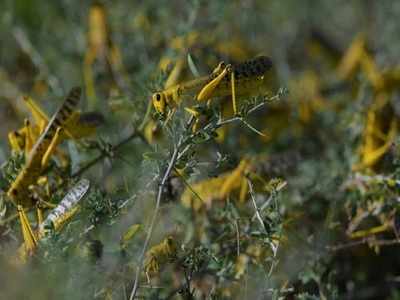
No threat to urban areas from locusts: FAO expert
by Vishwa MohanRepresentative photo
NEW DELHI: Extent of locust invasion may get wider and swarms may reach as far as Bihar and Odisha in June-July before it would eventually return to Rajasthan with progress of the monsoon.
Its impact in cities, including Delhi, will, however, not be felt as the locust simply overfly urban areas without troubling humans.
India was informed by the UN’s Food and Agriculture Organisation (FAO) this week that “several successive waves of invasions can be expected until July in Rajasthan with eastward surges across northern India as far as Bihar and Odisha followed by westward movements and a return to Rajasthan on the changing winds associated with the monsoon”.
Referring to the FAO’s latest locust status bulletin, the agriculture ministry on Friday
said the swarms were, however, less likely to reach south India, Nepal, and Bangladesh.
“Locusts don’t like urban areas. They simply overfly these areas where they don’t have much to eat. They don’t attack humans,” said Keith Cressman, senior locust forecasting officer with the FAO on Friday.
He also indicated that the swarms, currently noticed in different states in north and central India, would eventually move to western part of Rajasthan with the progress of monsoon as they find desert as their most appropriate breeding ground.
Cressman was responding to a question of environmentalist Sunita Narain who during a webinar on the issue, organised by the Centre for Science and Environment (CSE), asked him specific question on threat to Delhi while referring to advisories issued by the city government on possibility of locust attack in the Capital.
Unlike its usual period of invasion during monsoon, the locust swarms entered border districts of Rajasthan and Punjab in April and then gradually moved with wind direction to interior districts of different states.
Category-wise, it has already passed the ‘outbreak’ stage and now reached the higher stage of ‘upsurge’ in terms of intensity and extent.
Cressman said there was no need to panic as it would reach the stage of ‘plague’ (considered devastating for standing crops and vegetation) only at the end of this year if it is not controlled effectively before that.
Expressing his confidence in India’s ability to deal with it, Cressman, who had visited Rajasthan in January to see the preparedness, said the country has one of the best locust control mechanisms and it had successfully controlled the invasion in the past. He said, “India is well equipped and has the oldest national locust programme in the world.”
As India has already stepped up its locust control efforts in affected states, Union agriculture secretary, Sanjay Agarwal, held a meeting with officials of civil aviation ministry, National Disaster Management Authority (NDMA) and the Pawan Hans regarding use of aerial spraying of pesticides for locust control by using helicopter / aircraft / drones.
Besides, the home ministry has written to chief secretaries of all the states and gave necessary instructions to streamline the inter-state movement facility for the personnel engaged in locust control works.
Usually, the locust swarms enter India through Pakistan for summer breeding in the month of June/July with the arrival and progress of monsoon. Its incursion this year, however, happened early because of presence of residual population of locust in Pakistan which the neighbouring country couldn’t control during last season.